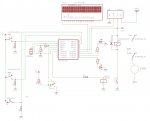Hello all,
I have a project to my house,
when it's rainning too much, water comes to my cellar, I need to pull out the water, I make a vertical drain, I put the pump and sensors inside
PICAXE give a solution, It's a project without claim
I find a solution, that's one solution, it's not the best!
but, for me, it's enough
I use PICAXE 18, because after, I want to improve the project
I have a pump with 2 water sensors:
one for Low level, the second for High level
and a switch for manual mode (pump=ON during 3 minutes)
when water arrive, the Low level is ON:
- I start a timer
- If the High sensor is ON before end of timer, pump= ON
and wait low sensor=OFF, pump=OFF
- if the high sensor is OFF and the timer is over, pump=ON
and wait low sensor=OFF, pump=OFF
informations send to a Transmitter (TX-4MAVSA10 AUREL)
and arrive on a receiver ( RX-AM4SF -AUREL)
the second PICAXE, give informations to 3 LED
0ne for Low level, one for High level, one when PUMP=ON
to improve the range, I work now on a repeater with TRXQ1-433
and also with a receiver with RSSI information
Anybody can give remarks on my project
I'm a newbie in PICAXE, I use only few code
Syntony
I have a project to my house,
when it's rainning too much, water comes to my cellar, I need to pull out the water, I make a vertical drain, I put the pump and sensors inside
PICAXE give a solution, It's a project without claim
I find a solution, that's one solution, it's not the best!
but, for me, it's enough
I use PICAXE 18, because after, I want to improve the project
I have a pump with 2 water sensors:
one for Low level, the second for High level
and a switch for manual mode (pump=ON during 3 minutes)
when water arrive, the Low level is ON:
- I start a timer
- If the High sensor is ON before end of timer, pump= ON
and wait low sensor=OFF, pump=OFF
- if the high sensor is OFF and the timer is over, pump=ON
and wait low sensor=OFF, pump=OFF
informations send to a Transmitter (TX-4MAVSA10 AUREL)
and arrive on a receiver ( RX-AM4SF -AUREL)
the second PICAXE, give informations to 3 LED
0ne for Low level, one for High level, one when PUMP=ON
to improve the range, I work now on a repeater with TRXQ1-433
and also with a receiver with RSSI information
Anybody can give remarks on my project
I'm a newbie in PICAXE, I use only few code
Syntony
Attachments
-
2 KB Views: 12
-
428 bytes Views: 10




